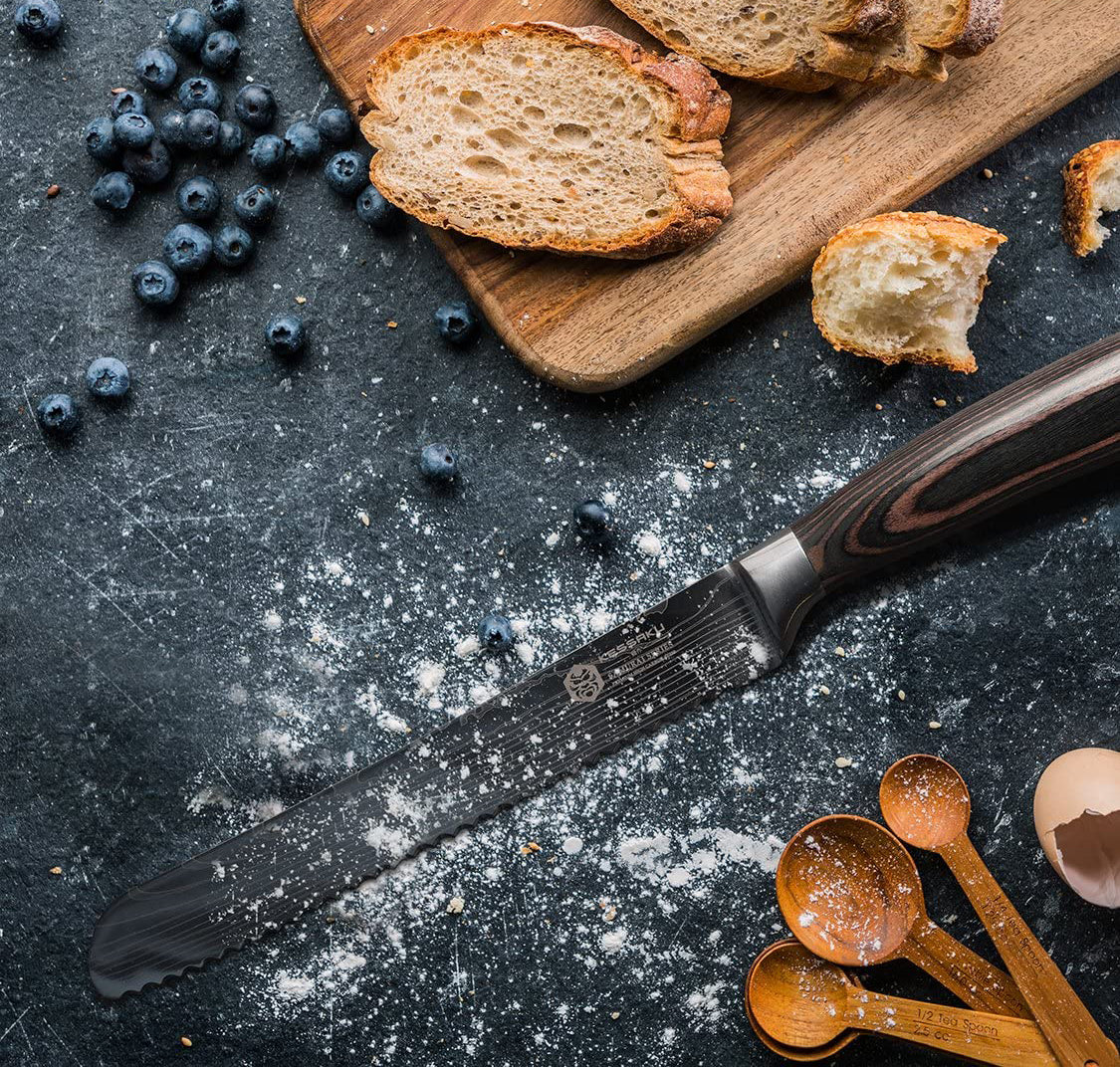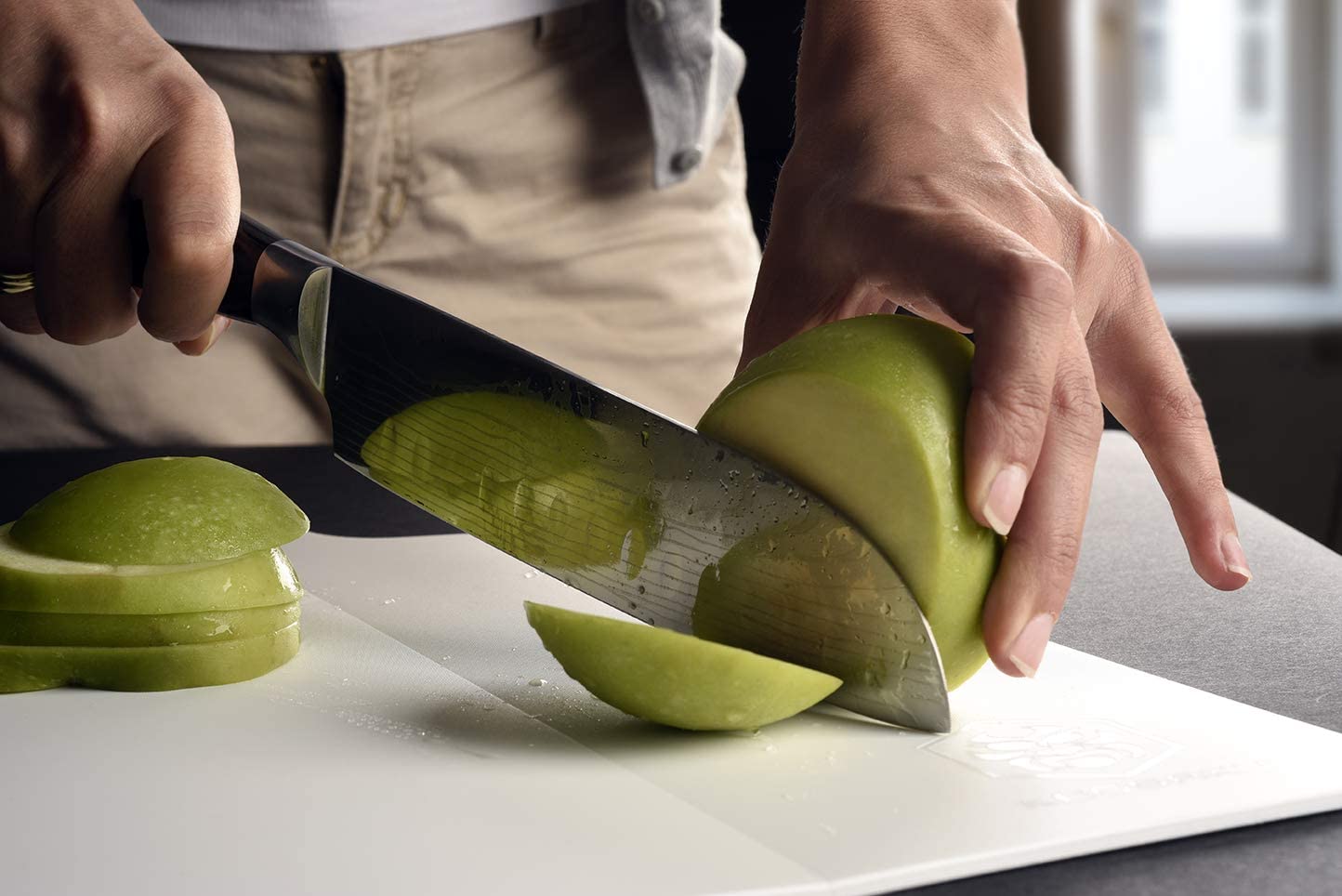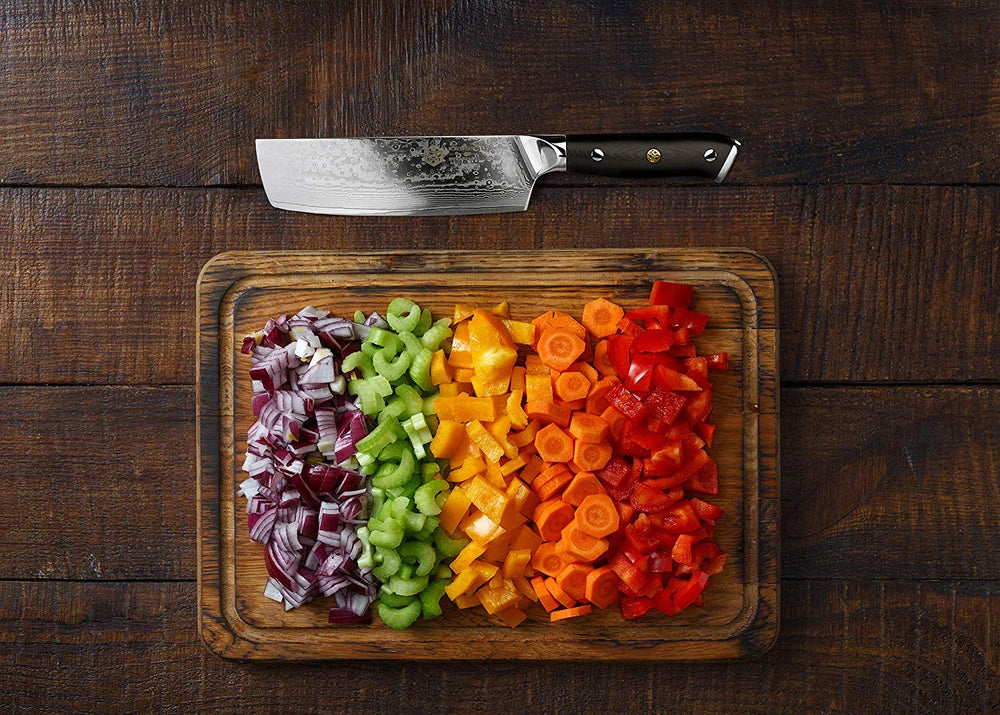How to Hone and Sharpen Your Knives
HONING
When viewing a knife’s blade under a very strong microscope, its edge will look like a series of tiny points. Over time and frequent use, these points can get pushed down and bent out of shape.
Honing realigns and straightens that edge, removing an edge’s “burr” (the steel folding over itself) for smoother, safer, cuts. Regular honing will result in a less frequent need to sharpen.
Ideally, it’s best to hone your blade’s edge before every use. It only takes 30 seconds and will help keep your knife perpetually sharp. By dutifully honing you may be able to go a year or even longer before having to sharpen.
If you don’t already own a high quality honing steel, you can learn about our Dynasty Series 10" Honing Steel.
IMPORTANT HONING TIPS
- Only move the knife, always keep the honing rod stationary.
- Only the edge of your knife's blade should ever touch the steel rod. (To avoid scratches, never let the side of the blade touch the steel rod).
- Proper honing requires very little pressure. Don’t press hard. Just a little more than the weight of the knife itself. Listen to the steel as you work. A harsh rasping noise indicates that too much pressure is being applied. A quiet ring signifies a proper, featherlike, stroke is being used.
- Find the right angle and keep it there. It's important to maintain the original angle of your blade across the steel rod. (Usually around 14-16 degrees for Japanese styled knives, and 20 degrees for Western knives).
- When in doubt, start with an angle that is steeper (smaller) than you need, then widen it out. This kind of adjustment will protect your knife’s edge, as opposed to starting with too wide an angle which can adversely affect your knife’s edge.
- Move the knife in slow even strokes so that you can maintain complete control of the knife at all times, to protect your hand while holding the honing rod.
- Do not bang the knife against the finger guard since this can damage the edge.
- When honing no longer gives the desired results it’s time to sharpen your knives on a whetstone.
HOW TO SAFELY USE A HONING ROD.
Although honing can be accomplished in any number of positions, the method described below makes it particularly easy to maintain the proper angle. It’s also safer because the blade is not moving toward either your hands or your body. Throughout honing, make sure to maintain the proper angle between the blade and the steel (usually between 14-16 degrees for Japanese styled knives, 20 degrees for Western knives).
Step 1: Hold the honing rod vertically with its tip firmly planted on your cutting board (or, non-slip surface). This is best performed on low table, at the level of your hips.
Place the heel of the blade against the top of the steel and point the knife tip slightly upward. Hold the blade at the angle away from the steel that matches the blade’s edge. (Lock your wrist and elbow to keep the angle consistent throughout).
Step 2: While using very light pressure and constantly maintaining the proper angle between the blade and the steel, start at the heel (or base) of the knife and the top of the hone and pull the knife toward you in a sweeping motion as you let the blade slide down. By the time the blade reaches the tip of the hone, you should be at the tip of the knife. Again, Use very light pressure. (Also, avoid letting the tip of the knife slide off the edge of the hone. Try to stop while it’s still on the rod, to avoid the risk of rounding the tip over time.
Finish the motion by passing the tip of the blade over the bottom of the steel.
Step 4: Repeat this motion on the other side of the blade. Go the other side of the knife on the opposite side of the hone. Go as slow as you want, speed has no effect whatsoever on quality!
Four or five strokes on each side of the blade should realign the edge.
Step 5: Alternate back and forth until you’ve done around 2 or 3 swipes per side. Check to see if your edge is sharp again. (If you find there’s very little improvement after doing 6 or 7 swipes per side, you’re either not honing at the correct angle, or your honing knife needs to be sharpened).
HONING CHEAT SHEET
- Quickly hone/steel your blades– ideally, just a couple of strokes before each use
- Keep the same angle, (or slightly less), as your blade’s sharpened angle, (usually 20˚ for Western knives, or 14 - 16˚ for Japanese knives). It’s better to err by being too shallow, and then going wider because using too wide an angle can adversely affect your blade’s edge whereas too shallow an angle will have no lasting repercussions.
- Lock your wrist and elbow to help keep the angle consistent
- Best performed on low table, at the level of your hips
- Use barely more pressure than the weight of the knife itself
- Avoid letting tip of knife slide off the edge of the rod
- Alternate side to side 2 or 3 strokes per side (with a maximum of 7 or 8)
SHARPENING
So, honing is for realigning a blade’s edge, by correcting misalignment. This differs from SHARPENING, which actually removes traces of steel from a blade’s edge to form a new edge.
Whetstones are considered the very best method of sharpening, as they’re more likely to ensure that your blade’s edge is restored to its original correct and proper geometry, allowing for maximum sharpness.
IN PRACTICE (to PERFECTION)
Developing the skill of correctly honing and sharpening your knives will help ensure the longevity of your knives and utensils, maximize their performance, and help retain the edges of your blades. Practice makes perfect.
SHARPENING
The very best method (by far) for sharpening is using a whetstone kit, the method used by all professional chefs to sharpen professional knives. This is because it allows you to perfectly sharpen without removing any excess steel.
Electric Sharpeners can also be used although we suggest ensuring it uses ceramic or diamond cutting wheels and can sharpen blades designed with steep cutting angles (Asian Style).
If you don’t already own a high quality whetstone kit, you can learn about our DELUXE PROFESSIONAL WHETSTONE KIT here.
Whetstone Sharpening
1. SOAKStart with a 1000-Grit (“course”) stone.
Place and soak the stone in cold water for 5 or 10 minutes.
You’ll know when the stone has absorbed the optimal amount of water when there are no longer air bubbles rising to the top. DETAILED HONING INSTRUCTIONS
It’s very important to find the correct angle between your knife’s blade and your stone and to keep and maintain that angle throughout this process.
- For example, our KESSAKU knives have an angle of 14º or 16º per side, depending on style and knife type.
3. METHOD STYLES.
There are two methods to choose from, depending on your own comfort and preference. The Pull Method (3b.) might be easier for beginners to master, as you don’t have to work in sections.
(a). The PUSH Method. (“The Traditional Asian Method”)
After finding your angle, grip the knife by the handle with either your thumb or index finger on the spine (depending on your knife’s style), to help guide your knife.
With your other hand, apply steady pressure across the blade’s surface with two or three fingertips placed close to the cutting edge, while constantly maintaining the proper angle for your blade against the stone.
Then, starting with the blade’s heel, push the knife forward and then relax the pressure as you pull it back towards you. After working on the heel for a few minutes, continue this same process for each section of the blade, moving from the heel upward to the blade’s tip.
(b). The PULL Method (“Western Style”)
After finding your angle, grip the knife by the handle with either your thumb or index finger on the spine (depending on your knife’s style), to help guide your knife.
With your other hand, apply steady pressure across the blade’s surface with two or three fingertips placed close to the cutting edge, while constantly maintaining the proper angle for your blade against the stone.
Starting with the heel of the blade on the top left corner of the stone, pull the blade back towards you diagonally by dragging the entire length of the cutting edge to the bottom right corner.
You can also start with the tip in the upper right corner of the stone and drag it diagonally down towards you, by dragging the entire length of the cutting edge to the bottom left corner.
The benefit of this method is that you don’t have to work in sections because the entire length of the blade’s edge runs across the stone, unlike the push method.
4. FEEL THE BURR.
A burr is a slight “shelf” on the edge of a blade that forms when honing and sharpening. It will feel like a small ridge or very fine wire at the edge of the blade opposite to the one you’re working on.
The secret to proper and correct whetstone usage is to sharpen on side of the blade until the burr forms on the opposite side. This indicates the side you’re working on is done.
To check the burr, you’ll want to run your fingertip or nail along the opposite edge to feel for it. Once you feel the burr, you’ll know it’s time to switch the blade’s side in order to hone and sharpen the opposite edge.
5. REPEAT STEPS 3 & 4 on the blade’s other side.
6. FEEL THE BURR II
The burr now acts as an indicator when a new edge is formed after adequately sharpening both sides of the blade. The burr, having served its purpose, now needs to be removed.
7. BYE BYE, BURR!
To remove the burr, just give the blade a few gentle passes along a 1000-Grit whetstone, using very light pressure, until the burr is removed.
8. FINISHING
Now, to finish, use a 6000-Grit stone after soaking it in cold water for 5-10 minutes.
Using the same technique as step 7, finish your knife to restore its surface shine and sharp edge by giving your blade a few gentle passes across the stone using very light pressure. You’ll likely only need a minute or two per side to achieve this.
9.TESTING
As you progress through each stage, you can keep checking the blade’s edge to ensure that it’s getting sharper.
After completing the steps with the (coarse) 1000-Grit stone, your knife should be sharp.
After completing step #8 (Finishing) with the fine 6000-Grit stone, your knife should pass the Push Cut Test for sharpness. (This means that your knife can cut through a sheet of paper by just pushing it down, gliding it through the paper, without any slicing forward or back motion).




